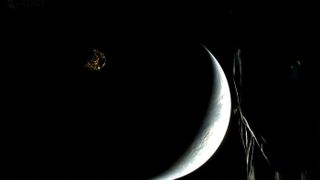
A SpaceX Falcon 9 rocket snapped a pretty special in-space selfie on Monday (Oct. 7).
The shot, captured during the launch of the European Space Agency's Hera asteroid-inspecting mission, shows a gorgeous blue Earth hanging in space beside the nozzle of the Falcon 9's upper-stage Merlin engine.
Earth looks smaller than it typically does in such launch photos, because it's quite far away from the camera: The upper stage was heading toward interplanetary transfer orbit, where it ended up deploying Hera successfully about 76 minutes after liftoff.

Getting to that orbit took a lot out of the Falcon 9's first stage as well. The booster didn't have enough fuel left over to come back to Earth for a safe landing, so the Hera mission was its 23rd and final flight, tying a SpaceX reuse record.
"Farewell, 1061, and we thank you," John Insprucker, a SpaceX principal integration engineer, said during the launch webcast on Monday, using the booster's numerical designation.
Related: SpaceX rocket launches Europe's Hera planetary defense probe to visit asteroid smacked by NASA
Hera is headed for a binary asteroid system consisting of a large space rock called Didymos and its smaller companion, Dimorphos. It will get there in late 2026, if all goes according to plan.
Get the Space.com Newsletter
Breaking space news, the latest updates on rocket launches, skywatching events and more!
NASA's Double Asteroid Redirection Test (DART) spacecraft slammed into Dimorphos intentionally in September 2022, demonstrating a technique humanity could use to knock a potentially dangerous asteroid off a collision course with Earth.
Hera will help scientists assess the effects of DART's impact, studying the crater the probe gouged out and confirming other changes noted by remote observation and modeling work, such as the shortening of Didymos' orbit around the system's common center of mass.
Hera is traveling with two cubesats, which will help the larger spacecraft with this work.
Join our Space Forums to keep talking space on the latest missions, night sky and more! And if you have a news tip, correction or comment, let us know at: community@space.com.

Michael Wall is a Senior Space Writer with Space.com and joined the team in 2010. He primarily covers exoplanets, spaceflight and military space, but has been known to dabble in the space art beat. His book about the search for alien life, "Out There," was published on Nov. 13, 2018. Before becoming a science writer, Michael worked as a herpetologist and wildlife biologist. He has a Ph.D. in evolutionary biology from the University of Sydney, Australia, a bachelor's degree from the University of Arizona, and a graduate certificate in science writing from the University of California, Santa Cruz. To find out what his latest project is, you can follow Michael on Twitter.